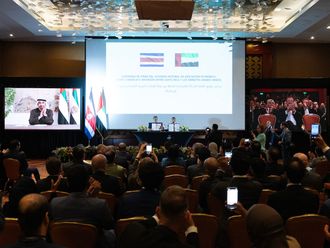Abu Dhabi: Together they stood united before the flag of their newborn federation — later described as the Arab world's most successful unity scheme.
And together the leaders of the United Arab Emirates built a state which combines a strong tradition of leadership with an ambiance of partnership; where tradition and modernity, Bedouin values and urban culture co-exist; and where individual aspiration and social unity are not mutually exclusive.
The founders transformed a traditional tribal society into a unified and progressive nation.
Their unshakable confidence in the future of the UAE as a federation, their capabilities and determination sustained it through difficult times.
Led by the late Shaikh Zayed Bin Sultan Al Nahyan, a visionary leader, the founders believed that unity would create strength, while disunity would expose them to domination by external powers.
Together they created a successful and enduring union for their people. They proved to be the right leaders in the right place at the right time.
Their quest for a new political entity began in mid-January 1968, when the British government suddenly announced that it was withdrawing its presence from the region.
The Rulers soon focused on the need to act collectively in the interest of their people. For more than a century, the British presence had placed limitations on their endeavours. At the same time, British military power had served a protective and deterrent function against some of the more ambitious neighbouring states.
As such, the diplomacy of the powerful states in the region, notably Saudi Arabia, Iran and Iraq, had all been predicated on the continuing British role.
But in 1968, that key element in the policy process was scheduled for removal by 1971, allowing little time for the states in the Gulf to formulate a clear alternative.
Underlying consensus
The crucial first step came as a result of an underlying consensus being reached by Shaikh Zayed Bin Sultan Al Nahyan and the late Shaikh Rashid Bin Saeed Al Maktoum.
An initial bilateral agreement between the two Rulers created a union between Abu Dhabi and Dubai on February 18, 1968. One critical factor that gave impetus to this agreement was the desire of both leaders to demonstrate to the other emirates how unity could work and prove beneficial.
Under this agreement, a single federal state would be formed with a common approach to foreign affairs, defence and security, medical and educational services and citizenship.
The pioneering agreement envisaged an open union, with its responsibilities and benefits extendible to other states.
Shaikh Zayed and Shaikh Rashid then invited the Rulers of the other five Trucial States to join.
Bahrain and Qatar were also invited to be part of the move toward greater unity — a move later proved to be an optimistic aspiration rather than a practical agenda for union.












